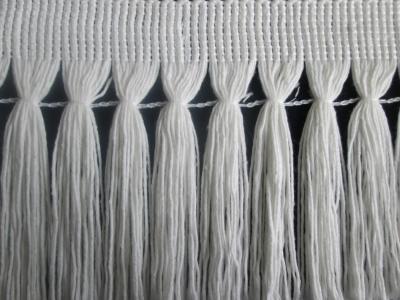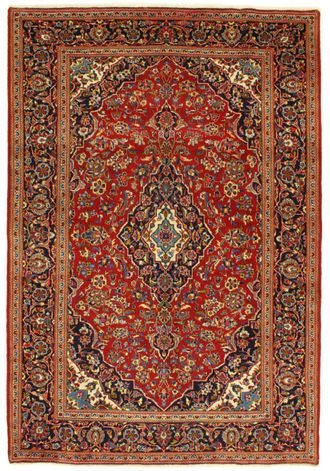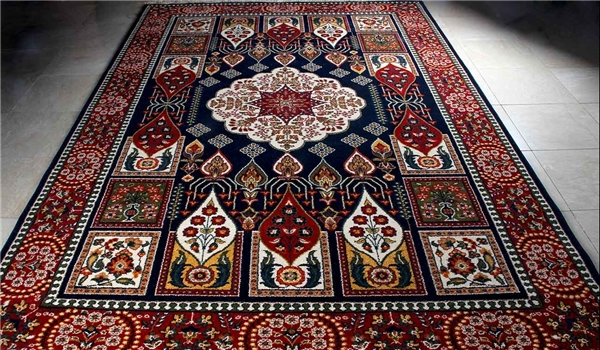
Submission:
It is a type of stitching that is applied to the roots of the carpet
in order to close the top and bottom ends of the carpet and to prevent nodules
from falling in a variety of
substrates. This increases the strength of the
woven head as well as
enhancing its appearance. Types
of leads include:
1. Two knots
2. Two window nodes
3. Chain
4. Pea node
5. Two color boat
6. Single color boat
1. Two nodes:
The most common and strongest type of lead is the two knots used for all types
of hand-woven. The way to do this is by arranging the roots according to the
number of carpets and the subtlety of the roots. First we place the head of the
yarn next to the first bunch of sticks and hold it with our hands. Then we
thread the two knots on the opposite fingers (forefinger and third finger) and
then we move the bunch of sticks through the created loop with the opposite
hand. Direct the loop to the end of the loop and cut the thread to tighten the
loop completely and repeat the operation on the loop again to complete two
nodes. During this operation the back of the carpet is toward the repairer, and
the constant stretching of the yarn in the repairer’s hand during the operation
and the proportion of roots in each batch are effective in the beauty and
uniformity of the two knots. This type of headband is usually made of sturdy
cotton.
2. Two window nodes:
This kind of decoration is decorative in addition to other properties
and usually due to the hard and time consuming implementation of this kind of
landscaping is carried out on undergrounds that are of special value and
material value. The operation of this node is similar to running two nodes.
After running two nodes at the beginning and end of the rug or undercarriage,
perform the same operation again. Divide the roots of the first two nodes into
two by dividing each half with the next half in a batch, this time with two
nodes on the batch. Run from the roots and do it all over the roots.
3. Chain:
Chain is another type of lead that is operated by a hook. After tying
the chain yarn to the first batch, place the yarn under the
roots. Then, using
the hook, pull the yarn out of the first bush to form a ring. Then pull the yarn
along the loop through the hook to create a loop to re-cross the thread between
the second and third claw batches, and so on. The disadvantages of this type of
stitching are that the rings are pulled together by pulling the strings, the
chains are opened and the stitching is split.
4. Pea node:
First, select the number of cords you want and hold them in your
right hand. Then place your left thumb on the root at the end of it and wrap it
around your thumb with the forefinger. Then remove the thumb from the root so
that the root is wrapped around two fingers. Then, insert the jumper between
your two fingers, remove the loop, and guide the knot to the end of the root
with the other hand, and tighten it. One of the disadvantages of this group is
the prominence of the roots and the faster disappearance of roots due to
overgrowth.
5. Two Color Boats:
It is a decorative bolt that runs through the needle on the roots,
and other bolts need to be fixed to complete the work to increase its strength.
As its name implies, it generally runs in two different cream colors, usually at
the beginning of the weaving or before the two knots. In this method the back of
the carpet is toward the repairer and after arranging the roots we cut the
desired cream through the needle to fit the carpet delicacy. Select one of the
needles and cross the handle up and down slightly and release the second needle.
The direction of motion of the second needle is the opposite of the motion of
the first needle. Move the second needle so that the second cream wraps
completely around the first cream. The operation should be cross-sectional in
order to allow the cream to be drawn. Cross-sectioning of the cream is necessary
because otherwise the creams are completely wrapped around each other and at the
end of the work weave the creams as wigs and eventually we use the other bolts
to hold the two-color boat stitching operation in place.
6. Monochrome Boats:
This type of lead is usually used to rebuild the facade of the knot
at the top and bottom of the carpet, which has a knot drop, yet the knuckles do
not tolerate stretching or so-called hanging. The way to do this is to wrap a
double batch of cream, like the first step of wrapping two knots on a batch.
Once wrapped in cream on the handle, it is enough to rebuild the knot view. We
will continue these steps as needed until the affected area is completed. After
the end of the operation, the node’s rear view is fully restored. To simulate
the appearance of the knots on the rug, we draw a boat on the rug to remove some
of its nails and make it flush with the surface of the nail.


